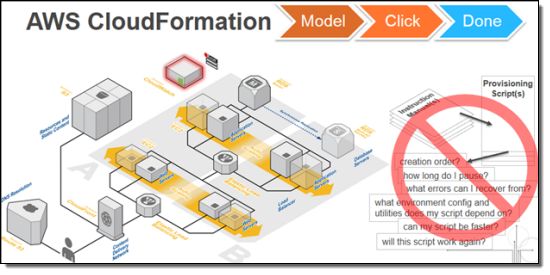AWS News Blog
AWS CloudFormation Adds Support for Redshift and More
My colleague Chetan Dandekar has a lot of good news for AWS CloudFormation users!
— Jeff;
AWS CloudFormation now supports Amazon Redshift. We have recently enhanced our support for other AWS resources as well.
What is CloudFormation?
AWS CloudFormation simplifies provisioning and management of a wide range of AWS resources, from EC2 and VPC to DynamoDB. CloudFormation enables users to model and version control the architecture they want in the CloudFormation template files. An architecture could be as simple as a single EC2 instance or as complex as a distributed database or the entire VPC configuration of an enterprise. (See CloudFormation sample templates). The CloudFormation service can automatically create the desired architecture (CloudFormation stacks) from the template files, without burdening the users with writing complex provisioning code.

CloudFormation speeds up provisioning by parallelizing creation and updating of stacks. The CloudFormation API lets you automate AWS provisioning and also gives you the ability to integrate it with the development and system management tools that you already use.
The CloudFormation templates can also be used to standardize and package products for broader users to use. (For example, an administrator can create a standard VPC configuration template for an entire developer team to use, and an ISV can package a distributed database configuration for its client to provision on AWS).
Amazon Redshift Support
![]() Amazon Redshift is a fast, fully managed, petabyte-scale data warehouse service. You can now launch and manage Redshift clusters using CloudFormation. You can also document, version control, and share your Redshift configuration using CloudFormation templates. Here is a sample CloudFormation template provisioning a Redshift cluster.
Amazon Redshift is a fast, fully managed, petabyte-scale data warehouse service. You can now launch and manage Redshift clusters using CloudFormation. You can also document, version control, and share your Redshift configuration using CloudFormation templates. Here is a sample CloudFormation template provisioning a Redshift cluster.
CloudFormation also supports the other AWS database services: Amazon RDS, Amazon DynamoDB, Amazon SimpleDB and Amazon ElastiCache.
Other Additions
Support for the following AWS features was added in early 2014:
- Auto Scaling scheduled actions and block device properties
- DynamoDB local and global secondary indexes
- SQS dead letter queue (DLQ)
- Updating Elastic Beanstalk applications
- Updating SQS queues and queue policy
- Updating S3 buckets and bucket policies
- Up to 60 parameters and 60 outputs in a CloudFormation template
Read the CloudFormation release notes for additional information on these changes.
To learn more about CloudFormation, please visit the CloudFormation detail page, documentation or watch this introductory video. We have a large collection of sample templates that makes it easy to get started with CloudFormation within minutes.